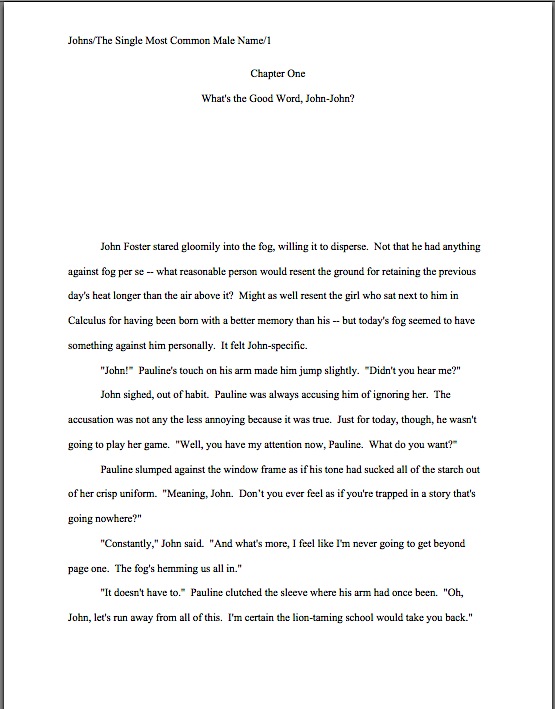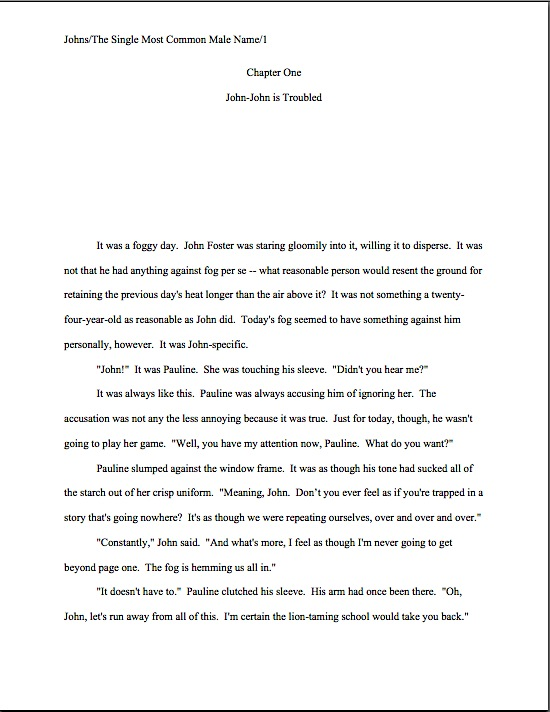I have time for only a quick one today, I’m afraid, campers, but at least the reasons are entirely appropriate, symbolically speaking: I shan’t be talking too much about humor in contest entries today because — wait for it — I’m in the throes of solidifying the contest rules for this summer’s Author! Author! Awards for Expressive Excellence. I shall be unveiling the criteria this coming Friday, but here’s a hint: at least one of the categories will be integrally related to something we shall be discussing today.
Ready, set — speculate!
On to the day’s business. Last week, I tempted the contest gods by bringing up the seldom-discussed topic of humor in entries and submissions. Contrary to popular opinion, not everything — or, alas, everyone — that seems funny to the writer will necessarily strike a professional readers as equally so on the printed page.
Or, as I put it last time:
Jokes that need to be explained after the fact are seldom funny to the reader.
While amusing real-life incidents often translate well directly to the visually-oriented worlds of film and TV, they do not always work equally well on the pages of a book.
Verbal anecdotes generally feature too little detail or context to be funny when reproduced as is onto the printed page.
Stop glaring at me. It’s true: funny anecdotes do not always funny prose make. Nor do hilarious real-life incidents. Also, verbal anecdotes are seldom redolent with character development, if you catch my drift. Caricature works beautifully there, but on the page, motivation becomes far more important. Not to mention backdrop and context.
All of that goes double for what’s funny on Facebook, unfortunately: quite a lot of everyday humor is situational. Or dependent upon the audience’s already being familiar with the characters and/or premise. As is quite a lot of sitcom humor, actually, but in social contexts, one’s kith and kin tend to cut one slack. Consequently, the amusement bar tends to hover quite a bit lower than it does in situations — like, say, when you enter a writing contest or submit to an agency — in which the prevailing standard of whether a piece of writing is funny is based upon whether it impresses impartial readers who could not pick the author out of a police line-up.
Translation: “But it made my friend/significant other/bus driver laugh out loud!” is not a reliable indicator of whether Mehitabel the veteran contest judge or Millicent the agency screener will find something funny on the manuscript page.
And how to put this gently?…often seems to come as a great big surprise to writers new to the art of making readers laugh, particularly memoirists and novelists that borrow heavily from their quotidian lives. “If an anecdote is funny verbally,” they apparently reason, “it should be equally amusing if I just describe the situation exactly the same way in writing, right?”
Actually, no. Why doesn’t this tend to work? Well, tone, for one thing: a talented anecdotalist puts on a performance in order to give his tale poignancy and point.
Good comic authors are well aware of this — did you know that both Mark Twain and Oscar Wilde, renowned in their day as hilarious public readers, routinely used to read crowds versions of their writing substantially different from what those same readers might buy in a bookstore, or even hear in a theatre?
This was exceedingly smart, in case you were wondering. Funny on a printed page and funny in from a podium can be quite different animals. Also, it was brilliant marketing: people who had heard them read could boast about how much more amusing these authors were in person. Great way to sell tickets to one’s next lecture tour.
On the page, though, none of those stage tricks work. Mehitabel and Millicent will not be able to imagine you saying the words in your manuscript out loud, after all. Nor can they possibly see what you are picturing. All they can judge your comic vision by is what is actually on the page.
But most aspiring writers and contest entrants don’t think of that, do they? Or so agents and editors surmise from the fact that surprisingly few humorous passages in submissions seem to reflect a serious attempt to convey a comic tone. Why bother? The situation is inherently funny, right?
Not necessarily. If the narrative does not adequately convey what was humorous in that real-life incident, it’s going to fall flat on the page.
“But why?” you gasp, poised to sacrifice a goat to Thalia.
Because all too often, the writer assumes fleshing out the funny is not necessary: in that verbal anecdote that’s been slaying ‘em for years, the hearers already knew enough about the teller (and, often, the situation) to be able to fill in any narrative gaps.
That’s an extremely dangerous assumption in a contest entry or submission. Let’s face it, neither Mehitabel nor Millicent is much given to filling in the humorous blanks to the hefty percentage of jokes whose appeal is best described by the common expression well, I guess you had to be there.
But the reader — both the one that needs to fall in love with your work before it can get published and the one that you hope will want to buy it after it’s published — wasn’t there, by definition. And even if s/he was, it’s not the reader’s job to try to figure out why humor on the page is funny; it’s the writer’s job to set up the amusing bits so well that the joke does not need to be explained.
It just makes the reader — any reader — smile. Yet another reason that it’s a great idea to seek out impartial feedback: the success of the line that made your mother choke with mirth and fall out of her chair may well depend upon the reader’s knowing about something that’s not currently showing up on the page.
You can’t know for certain if the only people you’ve been showing your writing share your life, after all. Since the point of publishing a book is, presumably, to reach people who did not, say, give birth to you, sit in the cubicle next to yours, or trundle down an aisle with you whilst one or both of you were wearing white, it honestly doesn’t make sense to think of your kith and kin as your target readers.
But that’s precisely who aspiring writers usually do envision as readers, isn’t it? Or so the pros surmise from the exceedingly high percentage of first-time memoirists and autobiographical novelists that murmur early and often, “But what will they think of me after I publish this?”
I can set your mind at rest on that, actually: if you’re writing about real events, at least a few of the people that were there will think your book’s depiction is wildly inaccurate. Heck, even some people who previously knew about those events only through your verbal anecdotes may regard your written version as coming from out of left field. That’s the nature of memory, as well as individuality; since everyone experiences events differently, everyone remembers them differently.
That’s why we say you had to be there, right?
Forgetting that the human experience is subjective, and thus requires fleshing out on the page, is frequently an issue when writing the real, but it seems to trip writers up especially often when they are trying to convey real-life humor. It’s just so easy to presume that the reader can picture every aspect of a remembered event; the writer does, right? That presumption is often the reason that the anecdote that’s been sending coworkers rolling in the proverbial aisles, causing tears of glee to burst from relatives’ eye sockets, and prompting best friends to say at parties, “Oh, Antoinetta, please tell that one about the parrot and the fisherman!” for years tends actually to be less likely to elicit a chuckle from someone that reads for a living than fresher material.
Why? Because in scenes written entirely from imagination, the writer knows for certain that he cannot rely upon the reader’s outside knowledge. The narrative is less inclined to rely upon elements that you had to be there to know.
Thalia is a demanding mistress, you see: she has a great affection for specifics. In ancient Greek, ?????? translates roughly as abundant festivity or blooming. So I like to think of comedy writing as being about expansion — of a funny premise, an amusing situation, or an oddball character.
Where I think most contest entries — and manuscripts — go wrong is in a tendency to contract a funny scenes, rather than expanding them. Due, perhaps, to that tired old truism about brevity’s being the soul of wit. Like all sweeping generalizations, this is not always true.
There’s plenty of hilarious lengthy humor out there, after all. Anyone that tells you otherwise is either a great lover of writing aphorisms, unfamiliar with the breadth of witty writing in the English language, or just plain too impatient to read anything longer than the back of a cereal box.
So there.
That being said, allow me to add hastily that when I suggest expanding funny scenes, I’m not talking about pacing — as anybody who has watched a TV comedy that doesn’t quite work can tell you, funny that drags can rapidly become tedious. But that shouldn’t mean rushing through the comic elements — or cutting away from a hilarious moment and back to stern narrative the nanosecond after a good quip.
You don’t want that funny line to look like a fluke to Mehitabel and Millicent, do you?
Physical comedy often gets rushed on the page, unfortunately, sometimes so much so that it’s hard for the reader to follow what’s going on. That’s particularly likely to happen in a narrative containing a lot of run-on sentences, I’ve noticed: I guess that writers fond of them just like flinging events onto the page as quickly as humanly possible.
But as Gandhi said, there’s more to life than increasing its speed. To which I would add: there’s more to writing comedy than a rapid telling.
I sense some aphorism-huggers shaking their heads. You want proof that a too-speedy telling can flatten the funny. Fair enough. Here’s a slapstick moment, conveyed with the breathless pacing and overstuffed sentences Mehitabel and Millicent see so much.
Harriet grabbed her usual wobbly table at the coffee house, shoving her laptop, backpack, an extra-grande (whatever that meant) mocha, a dog-eared novel, and her lunch onto the too-small surface because she was in too much of a rush to get online and answer the e-mail that Bertrand must have sent her by now. Of course, he hadn’t, but she quickly became engrossed in reading the fifteen other e-mails cluttering up her inbox because it was Monday, when everyone came dragging into the office, then remembered an hour later the million things that they hadn’t done last week and rushed to blame their procrastination on somebody else, which she hated. When a handsome stranger brushed by to claim his latte from the counter next to her, he knocked over her drink. She jumped up to try to yank her possessions out of the way, but she was too late, everything was soaked. She only managed to save her laptop, backing up so hard that she shoved her chair into the lady sitting behind her, causing a domino effect of café patrons slamming into each other. And now it was time to get back to work, and she hadn’t eaten even a bite of her lunch.
Awfully darned hasty, isn’t it? There are some funny elements here, but they get a bit lost in the welter of frenetic activity. And cramming all of it into a single paragraph doesn’t really do the scene any favors, either, does it?
So we can’t really blame Mehitabel for wanting to shout, “Whoa! Slow down and show us what’s happening!”
Glad to oblige. Here’s that scene again, shown at a more reasonable pace.
The lunchtime crowd of caffeine-seekers had, as usual, avoided the three-legged table. Harriet always brought her own shim to shove under the short leg. By the time she had coaxed the tabletop into something close to horizontality, Alex had shouted twice that her extra-grande (whatever that meant) mocha must be getting cold.
As usual, the cup seared her hand. She carried it with her fingertips until she could balance it atop the tenuous pyramid she had constructed: laptop atop a dog-eared paperback novel supported by her backpack, with her bagged lunch teetering on the last few inches of table. Food could wait until she powered up her computer and answered the e-mail that Bertrand must have sent her by now.
Of course, he hadn’t. What a jerk. Irritably, she gnawed on a mushy apple, scrolling through pointless e-mails from her coworkers. Typical Monday: everyone came dragging into the office, then remembered an hour later the million things that they hadn’t done last week and rushed to blame their procrastination on somebody else.
“George!” Alex screamed. “Do you want your latte or not?”
Suitably chastened, a handsome hipster lunged toward the counter. Sympathetic to his embarrassment, Harriet pretended to be engrossed in what was in fact the single most boring e-mail ever constructed by human hand. The hipster’s mailbag swung through her peripheral vision, and abruptly, she was covered with coffee.
Automatically, she yanked her computer away from the spreading lake soaking her possessions. Leaping to her feet, she sent her chair sliding backward into the cramped couple at the next table. They scrambled to save their drinks, but their sandwiches flew onto the floor. The woman reached to retrieve the plates, unfortunately at the same moment that a good Samaritan at a neighboring table dove for them as well. Their heads smacked together with a sickening thud.
“Oh, God,” the hipster said, battering Harriet with fistfuls of paper napkins. “I’m so sorry.”
She wished she had time to enjoy his mauling. She had to get back to work, and she hadn’t eaten even a bite of her lunch. Typical Monday.
Much clearer what actually happened now, isn’t it? Do I hear a cheer for showing, not telling?
I sense some disgruntlement in the peanut gallery. “But Anne,” brevity-lovers moan, “that’s a lot longer! The contest I’m entering has a short page limit — if I expand my scenes like this, I won’t be able to enter as much of my manuscript as I had planned! And what if Millicent’s boss asked me for the first 50 pages of my manuscript. I want to get as much of the story under her nose as possible!”
Ah, these are both common concerns. Would it astonish you hear that they simply wouldn’t make any sense to Mehitabel or Millicent?
Why? Well, Millicent’s is perfectly aware that if submission request specifies a page limit, there’s going to be more manuscript beyond what the writer has sent. So will Mehitabel, if she’s judging a book category that calls for the opening pages and synopsis. That means, in practice, that a writer would be better off making those opening pages sing than trying to cram as much plot into them as possible.
If you’re genuinely concerned about length, there’s another option here, but I hesitate to suggest it: if the story overall is not humorous and it would take too much page space to render a comic bit unquestionably funny, consider taking it out altogether. Humor is a great way to establish your narrative voice as unique, but as I mentioned earlier in this series, it can be a risky contest entry strategy. Ditto with submissions. Funny that fails tends to be disproportionately punished.
Why, you ask? Comic elements in an otherwise serious manuscript can come across as, well, flukes. They don’t fit comfortably into the overall narrative; the individual laugh lines may be genuinely funny, but if there aren’t chuckle moments and fleeting smirk instants throughout as well, the funny bit can sometimes jar the reader out of the story.
I know: it’s kind of counter-intuitive. But true.
You might also consider cutting comic bits that you’re not positive will work on strangers. Unless you are lucky or brave enough to be a stand-up comic, a teacher, a prison guard, or have another job that allows you to test material on a live audience unlikely to run screaming from the room, you honestly cannot tell for sure if the bits that seemed hilarious to you in the privacy of your studio would be funny to anyone else.
In case I’m being too subtle here: it’s a bad idea for your first test of whether a joke or comic situation works to be submitting it to a contest, any more than it should be when you submit it to the agency of your dreams. The stakes are just too high, and it’s just too easy to imagine theoretical readers laughing at the funny parts.
Not that I’d know anything about that, writing a blog.
“But Anne,” some of you complain, and who could blame you? “I love my comic bits, but the contest deadline is imminent. I don’t have time to track down impartial first readers. Is there a faster method to test-drive my funny parts?”
Until you’re sure that your narrative voice is consistently diverting, it can be very helpful to read it out loud to somebody. See where the chuckles come, if ever. If an expected chuckle does not come, flag the passage and rework it, pronto. (I’ve been known to ask, when a line elicits only a fleeting smile, which of the following three possibilities is funniest.)
Reading out loud is also one of the few ways to weed out the phenomenon I mentioned last time, what movie people call bad laughs, the unintentional blunders that make readers guffaw AT a book, not with it.
Fair warning: any given listener will be able to respond spontaneously only once to a particular scene. So after you have reworked the problematic parts, you’re going to need to track down another victim listener.
Thalia is nudging me to point out that living with a comedy writer is no picnic. Yes, ma’am.
This strategy only works, of course, if you are philosophically open to the possibility that the sentence that you thought was the best one-liner penned in North America since Robert Benchley died is simply not funny, and thus should be cut. Admittedly, this kind of perspective is not always easy to maintain: it requires you to be humble. Your favorite line may very well go; it’s no accident that the oft-quoted editing advice, “Kill your darlings,” came from the great wit Dorothy Parker.
Yes, that’s right: she was talking about laugh lines. That’s not how your high school English teacher introduced you to the aphorism, was it? God, I hate sweeping generalizations about writing; they’re so often applied indiscriminately.
It is pretty good advice about comedy, though. Be ruthless: if it isn’t funny on paper, it should go — yes, no matter how much it makes you laugh. Or your best friend, or your spouse, or everyone around the water cooler at work. (Do offices even have water coolers anymore?)
As any good comedy writer can tell you, in the long run, actually doesn’t matter if the author laughs herself silly over any given joke: the reaction that matters is the audience’s. And no, the fact that your spouse/mother/best friend laughed heartily does not necessarily mean a line is genuinely funny. It may mean merely that these people love you and want you to be happy.
A little hard to resent that kind of devotion, isn’t it?
Lacking an audience, it is still possible to work your way into Thalia’s good graces by editing out the only marginally comical in your manuscript. As a contest judge and editor, I can tell you with certainty that aspiring comedians’ less successful efforts seem to rush to array themselves into easily-identifiable groups.
Next time, I’ll give you a guided tour of ‘em, so you may recognize them if — Thalia forefend! — they should rear their less-than-funny heads in your contest entries. In the meantime, polish up those laugh lines, burnish those chuckle-inducing moments, and keep up the good work!






















